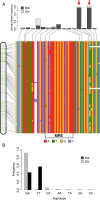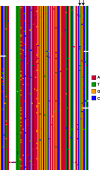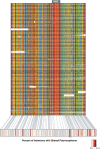Non-allelic gene conversion enables rapid evolutionary change at multiple regulatory sites encoded by transposable elements
- PMID: 25688566
- PMCID: PMC4384637
- DOI: 10.7554/eLife.05899
Non-allelic gene conversion enables rapid evolutionary change at multiple regulatory sites encoded by transposable elements
Abstract
Transposable elements (TEs) allow rewiring of regulatory networks, and the recent amplification of the ISX element dispersed 77 functional but suboptimal binding sites for the dosage compensation complex to a newly formed X chromosome in Drosophila. Here we identify two linked refining mutations within ISX that interact epistatically to increase binding affinity to the dosage compensation complex. Selection has increased the frequency of this derived haplotype in the population, which is fixed at 30% of ISX insertions and polymorphic among another 41%. Sharing of this haplotype indicates that high levels of gene conversion among ISX elements allow them to 'crowd-source' refining mutations, and a refining mutation that occurs at any single ISX element can spread in two dimensions: horizontally across insertion sites by non-allelic gene conversion, and vertically through the population by natural selection. These results describe a novel route by which fully functional regulatory elements can arise rapidly from TEs and implicate non-allelic gene conversion as having an important role in accelerating the evolutionary fine-tuning of regulatory networks.
Keywords: Drosophila miranda; evolutionary biology; genomics; non-allelic gene conversion; regulatory networks; transposable elements.
Conflict of interest statement
The authors declare that no competing interests exist.
Figures









Comment in
-
Spreading good news.Elife. 2015 Apr 2;4:e07108. doi: 10.7554/eLife.07108. Elife. 2015. PMID: 25838131 Free PMC article.
Similar articles
-
Spreading good news.Elife. 2015 Apr 2;4:e07108. doi: 10.7554/eLife.07108. Elife. 2015. PMID: 25838131 Free PMC article.
-
The Role of Gene Conversion between Transposable Elements in Rewiring Regulatory Networks.Genome Biol Evol. 2019 Jul 1;11(7):1723-1729. doi: 10.1093/gbe/evz124. Genome Biol Evol. 2019. PMID: 31209488 Free PMC article. Review.
-
Dosage compensation via transposable element mediated rewiring of a regulatory network.Science. 2013 Nov 15;342(6160):846-50. doi: 10.1126/science.1239552. Science. 2013. PMID: 24233721 Free PMC article.
-
Heat-shock promoters: targets for evolution by P transposable elements in Drosophila.PLoS Genet. 2006 Oct 6;2(10):e165. doi: 10.1371/journal.pgen.0020165. Epub 2006 Aug 17. PLoS Genet. 2006. PMID: 17029562 Free PMC article.
-
Transposable element influences on gene expression in plants.Biochim Biophys Acta Gene Regul Mech. 2017 Jan;1860(1):157-165. doi: 10.1016/j.bbagrm.2016.05.010. Epub 2016 May 25. Biochim Biophys Acta Gene Regul Mech. 2017. PMID: 27235540 Review.
Cited by
-
Long read sequencing reveals poxvirus evolution through rapid homogenization of gene arrays.Elife. 2018 Aug 29;7:e35453. doi: 10.7554/eLife.35453. Elife. 2018. PMID: 30156554 Free PMC article.
-
Single genome retrieval of context-dependent variability in mutation rates for human germline.BMC Genomics. 2017 Jan 13;18(1):81. doi: 10.1186/s12864-016-3440-5. BMC Genomics. 2017. PMID: 28086752 Free PMC article.
-
Epigenetics drive the evolution of sex chromosomes in animals and plants.Philos Trans R Soc Lond B Biol Sci. 2021 Jun 7;376(1826):20200124. doi: 10.1098/rstb.2020.0124. Epub 2021 Apr 19. Philos Trans R Soc Lond B Biol Sci. 2021. PMID: 33866802 Free PMC article. Review.
-
Contingency in the convergent evolution of a regulatory network: Dosage compensation in Drosophila.PLoS Biol. 2019 Feb 11;17(2):e3000094. doi: 10.1371/journal.pbio.3000094. eCollection 2019 Feb. PLoS Biol. 2019. PMID: 30742611 Free PMC article.
-
Gene Conversion amongst Alu SINE Elements.Genes (Basel). 2021 Jun 11;12(6):905. doi: 10.3390/genes12060905. Genes (Basel). 2021. PMID: 34208107 Free PMC article.
References
-
- Alekseyenko AA, Ellison CE, Gorchakov AA, Zhou Q, Kaiser VB, Toda N, Walton Z, Peng S, Park PJ, Bachtrog D, Kuroda MI. Conservation and de novo acquisition of dosage compensation on newly evolved sex chromosomes in Drosophila. Genes & Development. 2013;27:853–858. doi: 10.1101/gad.215426.113. - DOI - PMC - PubMed
-
- Alekseyenko AA, Peng S, Larschan E, Gorchakov AA, Lee OK, Kharchenko P, McGrath SD, Wang CI, Mardis ER, Park PJ, Kuroda MI. A sequence motif within chromatin entry sites directs MSL establishment on the Drosophila X chromosome. Cell. 2008;134:599–609. doi: 10.1016/j.cell.2008.06.033. - DOI - PMC - PubMed
Publication types
MeSH terms
Substances
Associated data
Grants and funding
LinkOut - more resources
Full Text Sources
Other Literature Sources
Molecular Biology Databases

